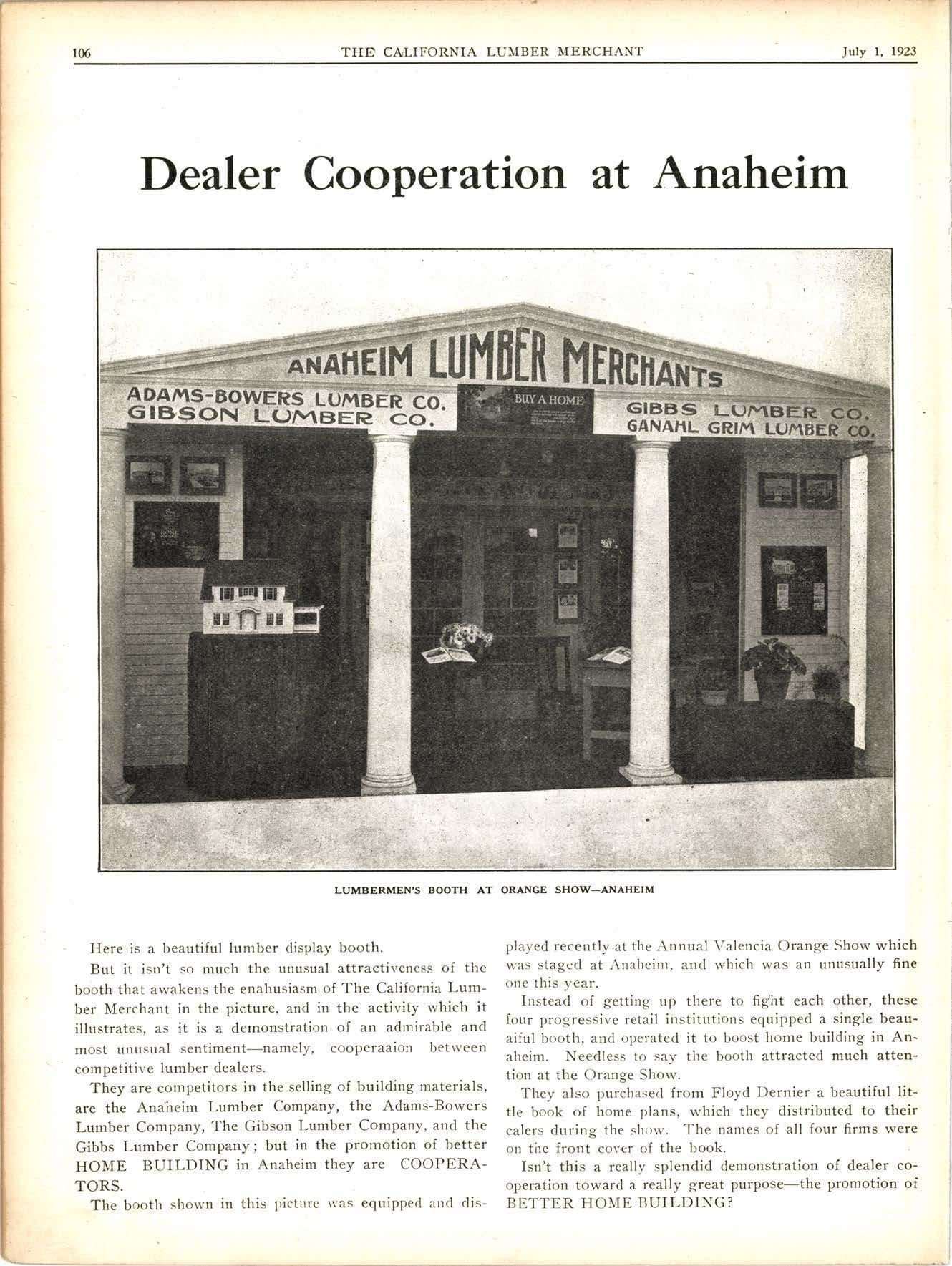
2 minute read
In and Out of the Yards
Heard Above the Whir of the
Planer and the Roar of the Rip Saw.
Bayside Steamship Company Organized
BY E. K. WOOD
The Bayside Steamship Company is the name of a ne\\' corporation that ihas been recently organized as a subsidiary to the E. K. Wood Lumber Company for the purpose of handling general tonnage other than lumber on three of their steamers, the Cascade, Olympic, and NIeridian.
SOUTHWEST LUMBER & SUPPLY CO. OPENS NEW LOS ANGELES YARD
A new retail lumber yard is being opened in Los Angeles in the stockyards district by a new corporation, The Southwest Lumber & Supply Company, which has just bee:t incgrporated with $50,000.
BROWN & DERRY LUMBER CO.
The Brown & Derry Lumber Company has just been incorporated at Vernon with $50,000 capital, by J. J. Brown, Julius Black, and A. A. Derby, Jr.
DIXON SASH & DOOR CO.
The Dixon Sash & Door Company, of Los Angeles, has opened a branch sales department in Glendale.
New Cement Price List Issued
A new cement price list went to the trade of Southern California on June 20th. No change in price was shown, but some corrections in freight rates were made.
Corrections In Report On Coast Counties Lumbermens Club
In dire report in the June 15th issue, of the formation oi the Coast Cou,nties Lumbermens Club, there was an error in the names of one or two of the offices.
The officers elected at this meeting were:
OFFICERS-C. H. Griffien, Jr., President, Santa D. O. Wenrich, lst Vice-President, Watsonville: Hargis, 2nd Vice-President, Salinas; O. E. Chase, urer, Pacifitc Grove; A. M. Sinclair, Secretary, 332 .Ave., Santa Cruz.
Cnuz; Wn-r. TreasSoquel
DIRECTORS-T. A. Work, Monterey; M. J. Campbell, King City; F. C. B,oock, Hollister; L.. M. Hebbron, Paso Robles; H. H. Hayward Watsonville; H. J. Steen, Santa Cruz; L. M. Tynan, Salinas.
Age Of Monterey Cypress
By Geo. B. Sudworth, Washington
The Monterey Cypress (Cupressus macrocarpa), a relative of the Old World Cypress tree (C. seinpervirens) oi the Egyptians and Romans, is one of several other Cali' {ornia conifers that grow naturally over very limited areas. The range of Monterey Cypress is confined to about two miles of California coast south of Monterey Bay, in a belt about two hundred yards wide extending from Cypress Point to Point Lobos. There seems to be evidence that it ever occupied a large range, although various conjectures are extant that it once grew in a. wider coastal belt, part of which is now submerged. It does n'ot appear that it is in imminent danger of soon disappearing from its rocky and sandy habitat, for it is constantly reproducing itself from seed. Moreover, the tree is extensively cultivatecl in the Pacific Coast from Washington t'o Lower California, while it is a familiar ornamental in European gardens, in mild climates of South America and in Aqstralia and New Zealanrl. Its ability to thriv'e away from the icoast and at elevations up to 20C0 feet was tested nearly 20 years ago in the San Bernardino Mottntains by T. P. Lukens of Pasadena.
The l'ongevity of this cypress has been long a matter of conjecture, with but little opportunity of determining the age of large trees, w'hch are ,from 5O to 7O feet in height and from 3 to sometimes 6 feet in diameter. F'ortunately last year the long looked for opportunity came of learning something definite about the age of these trees through lIr. E. L. Cuppy of Pacific Grove. The severe coastal storm of l9l7 uprooted a ,number of medium and 'large. sized trees in the Cypress Point grove. As the trunks were being sawed into sections Mr. Cuppy counted the stump rings of three trees which respectively showed ages of 200: 250 and, 300 years, the olde,st tree having a, trunk diameter of nearly six feet. Strangely enough, however, two other trees of unusually straight, thrifty growth showed respectively only 50 rings for a stump diameter of 2 feet, ancl 75 rings for a diameter.of 3 feet. Evidently the Monterey Cypress grows very rapidly in easily permeable,soil, the situations occupied by the latter trees, and much m'ore slowly in rocky situ.ations, the sites occupied by the older trees cited.










